The Samsung Galaxy S10+ Snapdragon & Exynos Review: Almost Perfect, Yet So Flawed
by Andrei Frumusanu on March 29, 2019 9:00 AM ESTGPU Performance & Power
On the GPU side of things, Qualcomm has long been leading the benchmark charts with the help of their in-house Adreno GPU architecture. With the Galaxy S10, we again see a new round of Adreno vs Mali in the Snapdragon and Exynos variants of the phone.
The Adreno 640 in the Snapdragon 855 has relatively conservative performance targets this generation. Here Qualcomm promises 20% better performance even though the GPU itself has a reported 50% more execution units. What has happened is that Qualcomm has dropped the clock frequency from 710MHz down to 585MHz, account for where most of that theoretical GPU performance is missing. The rationale here is to be able to run wider and slower, and thus more efficiently.
On the Exynos side of things, the new chip adopts a new Mali G76MP12 GPU clocked in at up to 702MHz. We’re already seen the GPU inside of the Kirin 980, however for whatever reason Samsung S.LSI has always been able to achieve better results than HiSilicon for several generations in a row, so it’ll be interesting to see how these two chipsets differ.
Starting off with the 3Dmark Sling Shot Extreme Unlimited test suite, the Physics workload is mostly a CPU bound test within a GPU thermally constrained scenario.
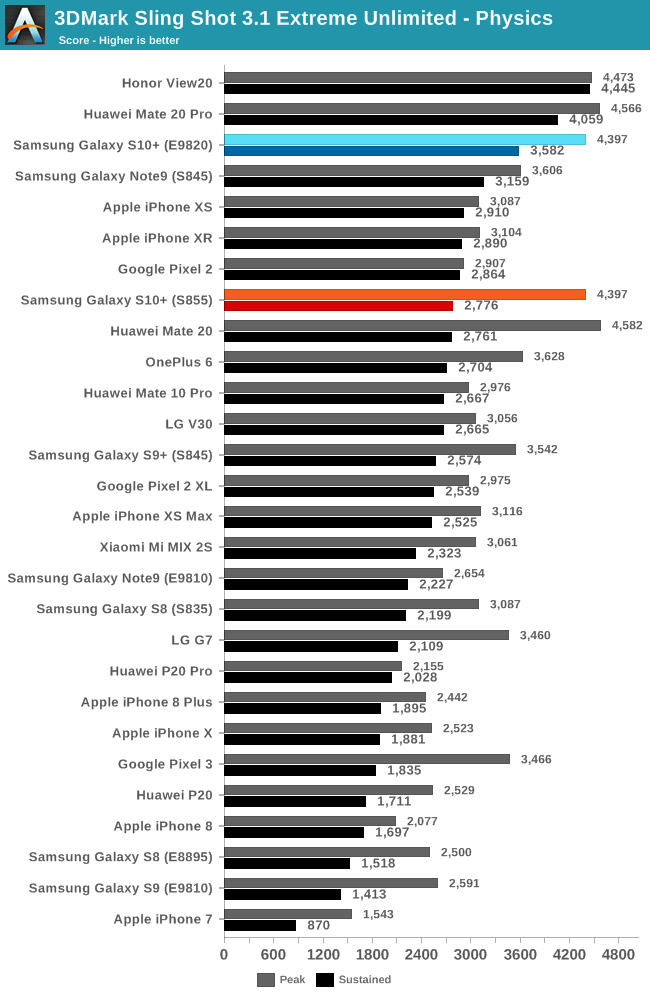
The Exynos 9820 surprisingly takes the performance lead between both Galaxy S10 units. The result here is a very big change compared to previous generation Exynos SoCs. I hadn’t had the time to investigate if this is actually caused by improvements of the new M4 core or if the workload is being scheduled on the A75 cores. Both peak performance and sustained performance here are very good and are only beaten by Kirin 980 devices.
The Snapdragon 855 Galaxy S10 also posts excellent peak perf results, however the CPU seem to throttle quite a bit more, falling in line with what last year’s Snapdragon 845 devices were scoring.
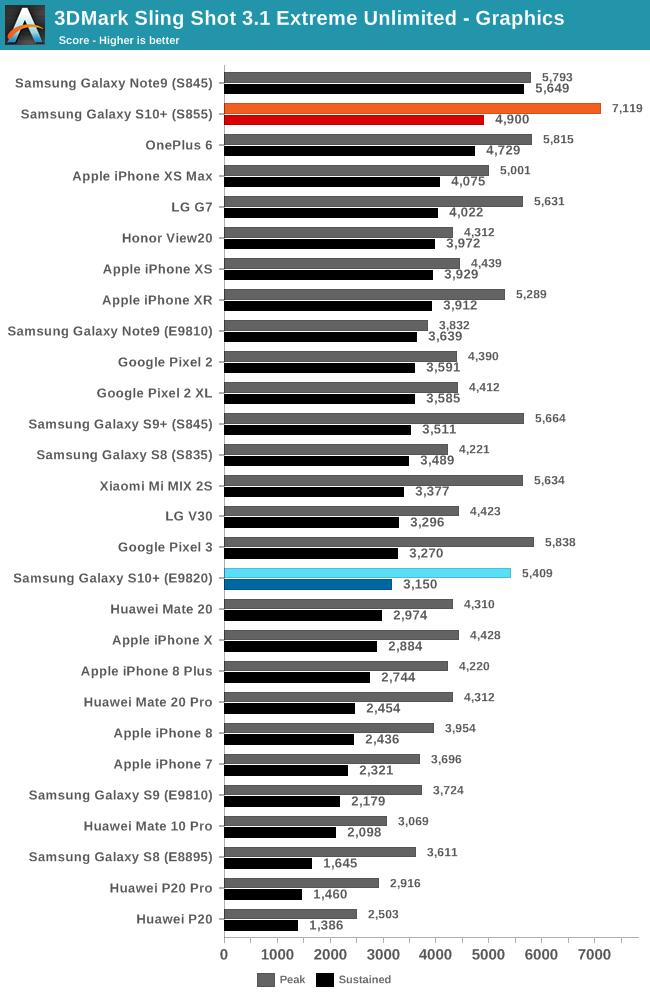
In the Graphics score of the workload, we come back to the familiar dominance of Qualcomm GPUs. What is interesting to see here is that both Galaxy S10 units sport worse sustained performance than the Note9 with last year’s chipsets. Most likely this is due to different thermal limits on these two Samsung devices.
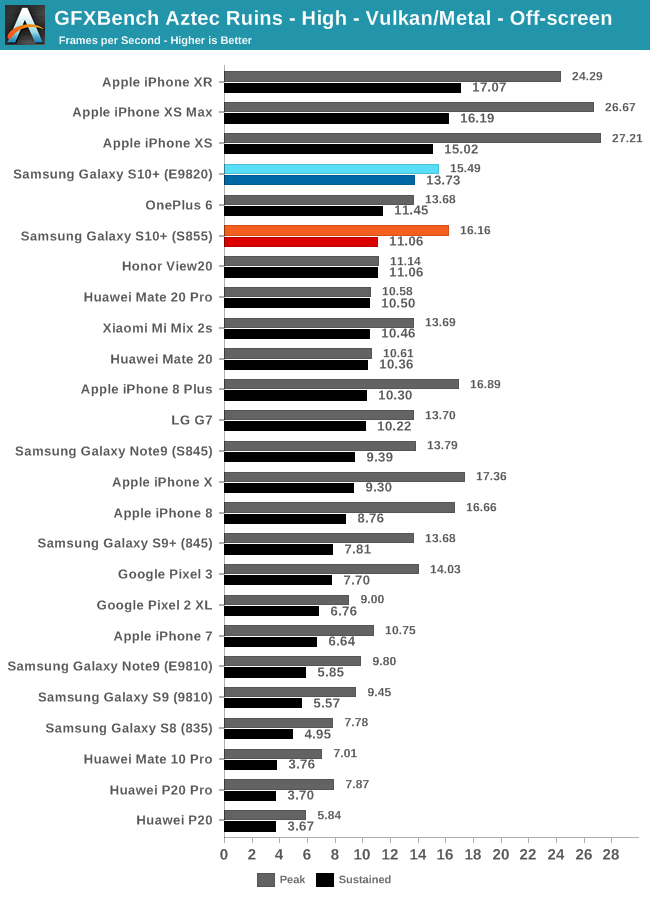

In the new GFXBench Aztec Ruins tests, the Exynos unit takes the lead in terms of sustained performance in the High variant test, only beaten by Apple’s newest iPhones. The phone doesn’t seem to reproduce the same lead in the Normal variant and subsequently slightly trails the Snapdragon 855 version. In sustained performance, the Exynos S10 beats last year’s predecessors, however the Qualcomm chip merely matches some of the better Snapdragon 845 devices from last year.
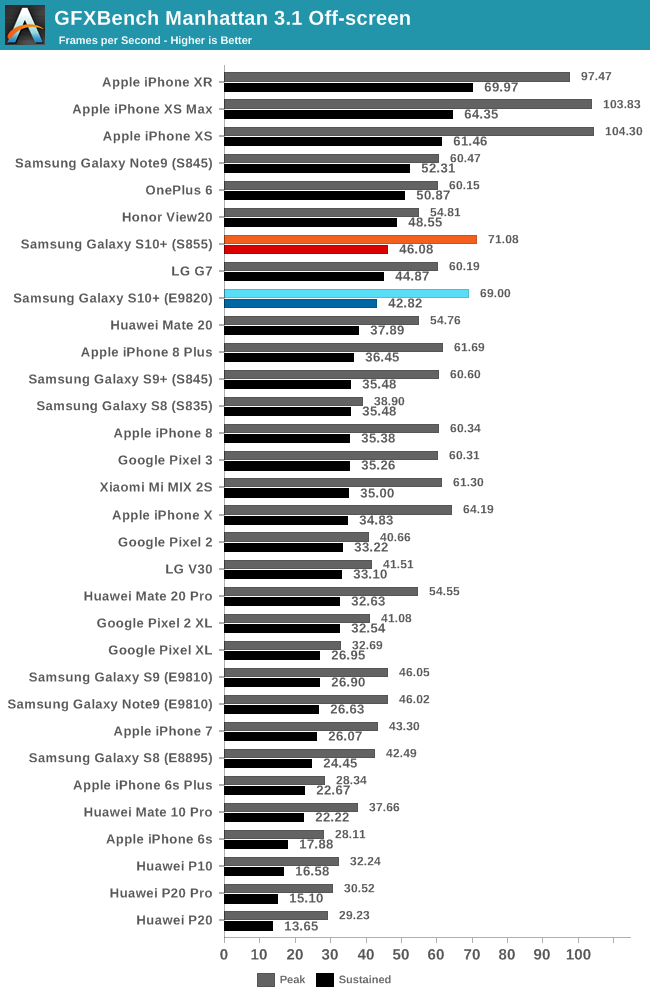
In Manhattan 3.1 Off-screen, we see both S10’s neck-in-neck in peak performance, and sustained performance also doesn’t seem all that different. The Exynos variant again shows big leaps over last year’s G72MP18 GPU, and the Qualcomm variant again is only able to match or actually lose out to some of the more thermally aggressive Snapdragon 845 units from last year.
| GFXBench Manhattan 3.1 Offscreen Power Efficiency (System Active Power) |
||||
| Mfc. Process | FPS | Avg. Power (W) |
Perf/W Efficiency |
|
| iPhone XS (A12) Warm | 7FF | 76.51 | 3.79 | 20.18 fps/W |
| iPhone XS (A12) Cold / Peak | 7FF | 103.83 | 5.98 | 17.36 fps/W |
| Galaxy 10+ (Snapdragon 855) | 7FF | 70.67 | 4.88 | 14.46 fps/W |
| Galaxy 10+ (Exynos 9820) | 8LPP | 68.87 | 5.10 | 13.48 fps/W |
| Galaxy S9+ (Snapdragon 845) | 10LPP | 61.16 | 5.01 | 11.99 fps/W |
| Huawei Mate 20 Pro (Kirin 980) | 7FF | 54.54 | 4.57 | 11.93 fps/W |
| Galaxy S9 (Exynos 9810) | 10LPP | 46.04 | 4.08 | 11.28 fps/W |
| Galaxy S8 (Snapdragon 835) | 10LPE | 38.90 | 3.79 | 10.26 fps/W |
| LeEco Le Pro3 (Snapdragon 821) | 14LPP | 33.04 | 4.18 | 7.90 fps/W |
| Galaxy S7 (Snapdragon 820) | 14LPP | 30.98 | 3.98 | 7.78 fps/W |
| Huawei Mate 10 (Kirin 970) | 10FF | 37.66 | 6.33 | 5.94 fps/W |
| Galaxy S8 (Exynos 8895) | 10LPE | 42.49 | 7.35 | 5.78 fps/W |
| Galaxy S7 (Exynos 8890) | 14LPP | 29.41 | 5.95 | 4.94 fps/W |
| Meizu PRO 5 (Exynos 7420) | 14LPE | 14.45 | 3.47 | 4.16 fps/W |
| Nexus 6P (Snapdragon 810 v2.1) | 20Soc | 21.94 | 5.44 | 4.03 fps/W |
| Huawei Mate 8 (Kirin 950) | 16FF+ | 10.37 | 2.75 | 3.77 fps/W |
| Huawei Mate 9 (Kirin 960) | 16FFC | 32.49 | 8.63 | 3.77 fps/W |
| Huawei P9 (Kirin 955) | 16FF+ | 10.59 | 2.98 | 3.55 fps/W |
Looking at the power consumption and efficiency tables in Manhattan 3.1, we see both devices showcase quite similar characteristics. Performance is very close in both chipsets, with also very similar power consumption within 220mW of each other. The efficiency also is quite close to each other. Interestingly both Qualcomm and Samsung weren’t able to close the gap to Apple’s latest iPhones and the A12 which still has a considerable performance and power efficiency lead.
For the Exynos chipset, it’s also unfortunate to see that absolute power has gone up by 1W, meaning the device will heat up faster, even though performance and efficiency is better.
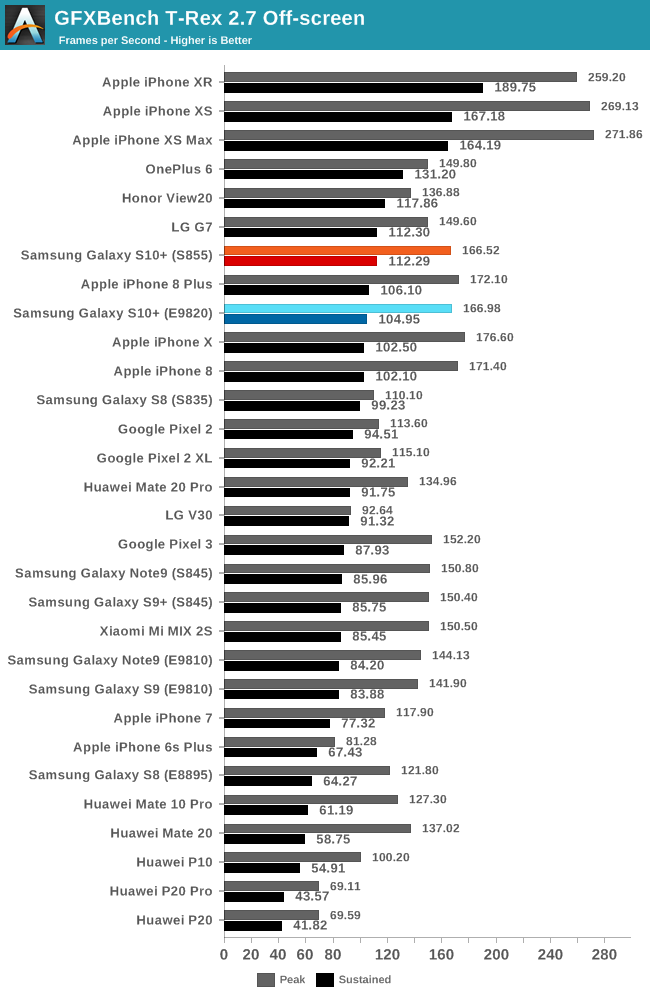
In T-Rex we again see both chipsets perform very similarly with similar sustained performance figures.
| GFXBench T-Rex Offscreen Power Efficiency (System Active Power) |
||||
| Mfc. Process | FPS | Avg. Power (W) |
Perf/W Efficiency |
|
| iPhone XS (A12) Warm | 7FF | 197.80 | 3.95 | 50.07 fps/W |
| iPhone XS (A12) Cold / Peak | 7FF | 271.86 | 6.10 | 44.56 fps/W |
| Galaxy 10+ (Snapdragon 855) | 7FF | 167.16 | 4.10 | 40.70 fps/W |
| Galaxy S9+ (Snapdragon 845) | 10LPP | 150.40 | 4.42 | 34.00 fps/W |
| Galaxy 10+ (Exynos 9820) | 8LPP | 166.00 | 4.96 | 33.40fps/W |
| Galaxy S9 (Exynos 9810) | 10LPP | 141.91 | 4.34 | 32.67 fps/W |
| Galaxy S8 (Snapdragon 835) | 10LPE | 108.20 | 3.45 | 31.31 fps/W |
| Huawei Mate 20 Pro (Kirin 980) | 7FF | 135.75 | 4.64 | 29.25 fps/W |
| LeEco Le Pro3 (Snapdragon 821) | 14LPP | 94.97 | 3.91 | 24.26 fps/W |
| Galaxy S7 (Snapdragon 820) | 14LPP | 90.59 | 4.18 | 21.67 fps/W |
| Galaxy S8 (Exynos 8895) | 10LPE | 121.00 | 5.86 | 20.65 fps/W |
| Galaxy S7 (Exynos 8890) | 14LPP | 87.00 | 4.70 | 18.51 fps/W |
| Huawei Mate 10 (Kirin 970) | 10FF | 127.25 | 7.93 | 16.04 fps/W |
| Meizu PRO 5 (Exynos 7420) | 14LPE | 55.67 | 3.83 | 14.54 fps/W |
| Nexus 6P (Snapdragon 810 v2.1) | 20Soc | 58.97 | 4.70 | 12.54 fps/W |
| Huawei Mate 8 (Kirin 950) | 16FF+ | 41.69 | 3.58 | 11.64 fps/W |
| Huawei P9 (Kirin 955) | 16FF+ | 40.42 | 3.68 | 10.98 fps/W |
| Huawei Mate 9 (Kirin 960) | 16FFC | 99.16 | 9.51 | 10.42 fps/W |
In the power end efficiency tables we however see a big difference between the two devices. Here Qualcomm is able to clearly achieve lower power and higher efficiency than the Exynos.
One thing that I note on both Galaxy S10 units is that I again saw some very odd thermal behaviour on the part of the Qualcomm unit. Just like we measured on the Note9 a few months ago, the Qualcomm Galaxy S10+ reached much higher initial temperatures than the Exynos S10+. I measured peak skin temperatures on the front screen near the SoC nearing 49°C on the S855 unit while the E9820 peaked around 43°C. Again, much like last year, this seems to be a time-bound boost mechanism as after a certain period of around 20 minutes the Snapdragon unit throttles down to a sustained 42-43°C. What this means is that the Snapdragon unit has higher (longer) peak performance figures at a cost of a hotter device, before both devices equalise at a sustained ~42°C.
Overall, the Snapdragon unit this year does still have a performance and efficiency lead, however the gap has been narrowed compared to what we’ve seen in the past years. The new Mali G76 looks to have made solid improvements, and ALU heavy workloads in particular have seen very large leaps compared to the Exynos 9810.
The Adreno 640 this generation just seems quite conservative – Apple has taken Qualcomm’s performance crown in mobile and most importantly also the efficiency crown. Both the Snapdragon 855 and A12 are both manufactured on the same process node so it’s a valid Dragon-to-Apples comparison, and here Qualcomm is beaten by such a significant margin of which in the past we’ve only been used to seeing Qualcomm beat Arm with. For the next generation, we thus hope both Qualcomm and Arm will be able to show more significant jumps in both performance and efficiency. Samsung’s own GPU is also a wildcard, however I’m not expecting to see this productised in next year’s Exynos.










229 Comments
View All Comments
luca.costantino - Friday, March 29, 2019 - link
Way too much bloatware on Samsung products for my taste. I would never consider buying a phone from them.shabby - Friday, March 29, 2019 - link
Are you offended or something? That's the dumbest comment I ever read, I just sold an s9 and wiped it, the buyer said I thought it would have more bloatware but it doesn't.liteon163 - Friday, March 29, 2019 - link
No need to be so harsh simply because you disagree with someone's opinion, dude. Don't be a jerk (that's not an opinion, that's a FACT proven by your initial reply).close - Sunday, March 31, 2019 - link
Samsung has their own equivalent of every single piece of software that comes with Android and you already didn't want in your phone. @shabby just wanted to tell us he knows how to follow a decrapify tutorial. The phone is still crappy software-wise but after putting in a lot of effort you can make it marginally less crappy. Yay?Vermite - Sunday, May 19, 2019 - link
You're an idiot. Yay?s.yu - Sunday, March 31, 2019 - link
There are smarter opinions and stupider opinions.goatfajitas - Friday, March 29, 2019 - link
Yes, it does have alot of bloat.mazook - Friday, March 29, 2019 - link
Dude, the ROM is about 4 GIGS.Think there's just a BIT of bloat in there?
Samus - Sunday, March 31, 2019 - link
I figured Android users are just used to bloat at this point. I’d you want a clean optimized mobile experience you either buy a Google phone, install a 3rd party ROM, or just buy an iPhone.notashill - Monday, April 1, 2019 - link
The "bloatware free" Android One ROMs are like 12 gigs though they do keep 2 entire copies of the system partition for the seamless update feature. Very annoying especially considering how many Android One devices have 32GB storage.